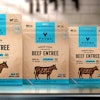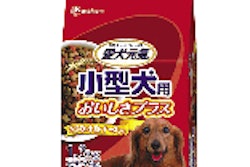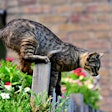I recently read a very interesting paper published in a prestigious veterinary journal regarding a study on the nutritional adequacy of commercial vegetarian petfoods (specifically, vegan cat foods). However, perhaps more interesting than the report itself was the niche industry's response to the study's findings.
The study
The paper appeared in the Journal of the American Veterinary Medical Association (Grey, et al., 2004). Basically, the study consisted of laboratory analysis of two commercially available vegan cat food products. The first (Diet A) was a supplement intended to be combined with other ingredients from the pet owner's kitchen (e.g., oil, flour, tomato paste) to make the complete meal. The second (Diet B) was a canned food intended to be fed alone as the sole source of nutrition. Each was reported to be claimed to meet the AAFCO Cat Food Nutrient Profiles for adult maintenance when fed as directed. Analyses of the prepared diets were compared to the appropriate AAFCO minimum and maximum values on a per 1,000 kcal ME basis.
Both products were found to have multiple nutritional inadequacies. Diet A was slightly-to-moderately low in the amino acids arginine, lysine, methionine and methionine/cystine, as well as pyridoxine and arachidonic acid. More critically, the taurine level was markedly low. On the other side, selenium and vitamin A were notably high. The vitamin A level approached the AAFCO maximum safe intake, and while there is no established maximum for selenium in cat foods, it approached the levels known to be toxic in other species.
Diet B was found to be slightly-to-moderately low in crude protein, methionine, methionine/cystine, arachidonic acid, phosphorus, niacin, pyridoxine and vitamin B12. More importantly, it was very low in taurine, calcium and vitamin A. No nutritional excesses were found in the analysis of Diet B.
The response
A Letter to the Editor appeared in the issue 10 weeks after the paper was published (Knight, 2005). Although the writer did not challenge the fact that deficiencies were noted in the analyses, it was his position that these must have been one-time flukes due to processing errors, but that the products are generally nutritionally adequate. Otherwise, the author of the letter contended, far more evidence of nutritional deficiencies would have been seen in cats consuming the products in the field. Regardless, it was firmly held that the study in no way contradicted the premise that cats could be successfully maintained on a vegan petfood.
The website of the letter writer goes into more details in response to the study, including comments from both manufacturers of the commercial products (www.vegepets.info/pages/vegetarian_feline_diets.htm). The manufacturer of Diet A was very apologetic, explaining in depth the possible reasons for the findings and promising that corrections would be made. For example, the probable reason for the high selenium and vitamin A, as well as the low taurine, could have been accidental substitution of one of the premixes in the formulation.
The manufacturer of Diet B, however, was notably unapologetic and stubborn in defense of the nutritional adequacy of the product. No explanation or excuse for the study's findings was offered. Rather, the suggestion of any problem with the product was simply refuted outright. Not only did the manufacturer purport that tens of thousands of animals are thriving on the product in the real world, but that "major sanctuaries use our products, because they have lower rates of illness and mortality (compared to meat-based commercial foods)."
My conclusions
I was commissioned to write an article on vegetarian diets for pets a few years ago (Dzanis, 1999). Because works produced by or for the federal government do not have copyright protection, it was picked up and copied on several other websites, and as a result, I was denounced by one chat room opinion maker as "completely anti-vegan." That surprised me, because I essentially agreed with the premise that a vegan diet for cats is at least theoretically possible, though I warned that meticulous attention to detail would be needed to assure nutritional adequacy and reasonable palatability. I also challenged the reader pondering such a diet for his or her pet to fully consider the reasons for the action, and suggested that if morally or philosophically committed to feeding a pet a vegan food, that he or she should consider a pet who would much more likely thrive and appreciate a herbivorous diet (e.g., psitticine birds, rabbits, iguanas, tortoises).
The contention in the Letter to the Editor that the deficiencies found in the study were isolated incidences is unlikely. I could buy that explanation if a particular batch of one of the vegan diets that were sampled just happened to be slightly off in one or two nutrients. However, if the premise was true, I would speculate that the statistical odds of picking up two different batches of products and finding both to be deficient at the same time to be very low. Further, the multitude of unrelated problems in both of the vegan products suggests more than minor, rare slip-ups to me.
I would also challenge the presumption that if the diets were in fact deficient that much more evidence of such would have been seen in animals fed the commercial product. The AAFCO Profile values include safety factors to ensure the vast majority of animals on the product receive nutritionally-adequate amounts of all nutrients, so many animals may still squeak by on diets that are marginally deficient compared to AAFCO values. Even in the case of severe deficiencies of some nutrients (e.g., calcium, vitamin A, taurine), signs in an adult at maintenance may take months to years to become clinically evident, especially if the body stores of that nutrient are ample prior to starting the deficient diet.
Also, even if the pet owner is diligent about maintaining a vegan feeding regimen, the occasional mouse, bird or treat from a sympathetic neighbor might be sufficient to keep the animal reasonably replete in nutrients. Finally, the advent of complete and balanced petfoods has made the prevalence of nutritional deficiencies increasingly rare, and since signs are often subtle or non-specific, these diseases may be easily overlooked or misdiagnosed.
The fact that apparently only one sample of each product was analyzed is a fault of the study, and leaves it open to the speculation that the products are typically nutritionally adequate. However, that premise should be pretty easy to refute with further analysis. I hope the authors of the study will pick up the gauntlet by conducting further testing and publishing their findings. If possible, subjecting these products to feeding trials under controlled conditions (e.g., AAFCO protocols) would also seem justified. In the interim, this study should serve as notice to manufacturers to practice due diligence in the formulation of these types of products.
References
Dzanis, D.A., 1999. Vegetarian diets for pets? FDA Veterinarian IX(3):3-5, May/June.
Grey, C.M., Sellon, R.K. and Freeman, L.M., 2004. Nutritional adequacy of two vegan diets for cats. JAVMA 225(11):1670-1675.
Knight, A., 2005. In defense of vegetarian cat food (letter). JAVMA 226(4):512-513.

















